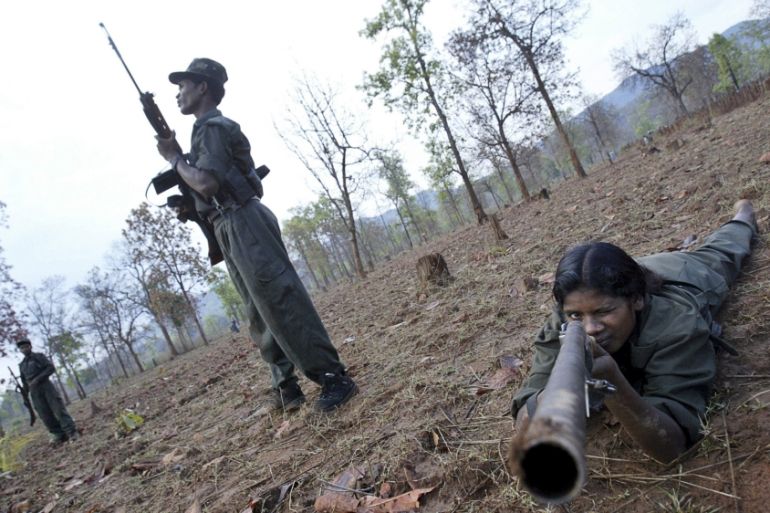‘Maoists’ kill 25 troops in worst attack in seven years
At least 25 soldiers killed in one of the worst attacks on the security forces in Chhattisgarh state, police say.

Suspected Maoist rebels have killed at least 25 paramilitary soldiers on Monday in a remote part of central India, a police official said, in the biggest attack in seven years.
The soldiers were guarding road workers in the Sukma district, nearly 400km from Raipur, the capital of Chhattisgarh state, when they came under fire. The rebels fired from hilltops at the group of soldiers, police officer Jitendra Shukla said.
Local channel, CNNNews18 television, quoted a paramilitary soldier as saying that hundreds of rebels attacked members of the Central Reserve Police Force (CRPF) and there was an exchange of gunfire between the two sides.
The CRPF said at least six of its personnel, who were critically injured, were airlifted to Raipur, the state capital.
HM Rajnath Singh, Chhattisgarh CM Raman Singh & MoS Home Hansraj Ahir pay tribute to 25 CRPF Personnel who lost their lives in #Sukma pic.twitter.com/SL7OUKOSJE
— ANI (@ANI) April 25, 2017
The attack is the latest in a long-running conflict between Maoist fighters and Indian forces in the forests and rural areas of mainly central and eastern India. At least 76 CRPF personnel were killed in a Maoist attack in the same district in 2010.
Raman Singh, Chhattisgarh’s chief minister, said: “This is the last fight … [Soldiers] are going inside with bravery. The pressure of security forces increased [and] the attack is the result of [Maoist fighters’] annoyance.”
IN PICTURES: India’s Maoist heartland
Ram Sewak Painkra, the district’s home minister, claimed to have “expelled Maoists from most parts of Chhattisgarh. Today’s happening shows little mistakes [by] security forces”.
| Timeline: Maoist attacks |
|
Federal Home Minister Rajnath Singh announced his deputy Hansraj Ahir will travel to Chhattisgarh to take stock of the situation.
However, Prakash Singh, a former police chief, said that there was a lack of coordination between local and central police forces.
“Secondly, the government of India always tries to send a message that the Maoist problem will end within five years. No sooner does this type of statement reach the Maoists, that they react with full capacity to prove their existence and strength. Today’s attack is a message by Maoists that they are no weaker than the forces,” Singh told Al Jazeera.
Prime Minister Narendra Modi sent his condolences to the families of the soldiers and expressed his anger in a series of tweets following the raid.
Attack on @crpfindia personnel in Chhattisgarh is cowardly & deplorable. We are monitoring the situation closely.
— Narendra Modi (@narendramodi) April 24, 2017
Decades-long conflict
Last month Maoist rebels killed 11 paramilitary policemen in the same state after ambushing their convoy.
The Leftist rebels say they are fighting for the rights of tribal people and landless farmers against mining in the mineral-rich region.
They have been fighting for more than three decades, staging hit-and-run attacks to press their demand for a greater share of wealth and more jobs for the indigenous people, the adivasis, who are among the poorest in the country.
READ MORE: India’s Maoist challenge
The Maoists are believed to be present in at least 20 states but are most active in Chhattisgarh, Orissa, Bihar, Jharkhand and Maharashtra.
Home Minister Singh said in a recent statement in parliament that the Maoists are frustrated because of the success of recent security operations against them. He said that last year, 135 rebels were killed, 700 were arrested and another 1,198 surrendered to government forces, according to the New Delhi Television news channel.
Government has deployed tens of thousands of troops to root out five-decade old armed rebellion.
The violence is believed to have cost tens of thousands of lives, with much action focused around the rebel-dominated “Red Corridor” stretching through central and eastern India. More than 2,000 people, mostly civilians, have been killed in the past two decades alone.
Critics believe attempts to end the revolt through security offensives are doomed to fail, saying the real solution is better governance and development of the region.
Additional reporting by Alok Putul from Raipur